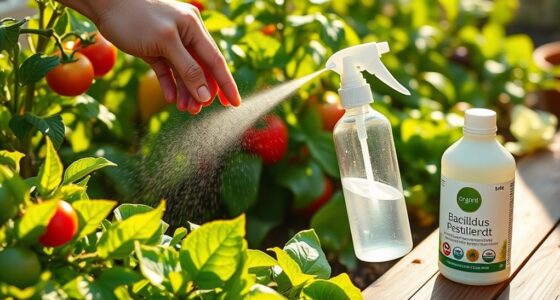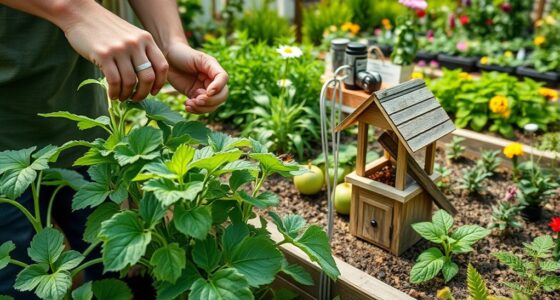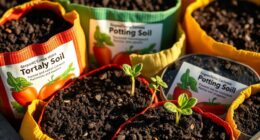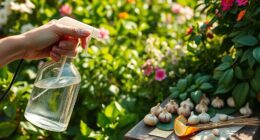Integrated Pest Management (IPM) is a sustainable approach that helps you control pests while protecting the environment. It combines techniques like encouraging natural predators, practicing crop rotation, and using mechanical barriers, reducing reliance on chemicals. By understanding pest biology and vulnerable stages, you can target pests effectively. This balanced method promotes healthy plants and minimizes risks. Keep exploring to discover more ways IPM can help you maintain a thriving, eco-friendly garden.
Key Takeaways
- IPM is an environmentally friendly approach combining biological, cultural, mechanical, and chemical methods to manage pests effectively.
- It emphasizes understanding pest biology and vulnerable stages to target control measures efficiently.
- Crop rotation and habitat manipulation are used to disrupt pest life cycles and reduce infestations.
- IPM promotes monitoring and thresholds to determine when interventions are necessary, minimizing chemical use.
- The goal is to maintain healthy, productive gardens sustainably by integrating diverse pest management strategies.

Have you ever wondered how farmers and gardeners keep pests under control without relying solely on chemical pesticides? The answer lies in understanding pest biology and applying strategic practices like crop rotation. Pest biology refers to the life cycle, behavior, and habits of pests, which is vital for managing them effectively. When you understand how pests grow and reproduce, you can anticipate their movements and target them more precisely. For instance, knowing that certain pests lay eggs on specific plants at particular times allows you to time interventions better, reducing the need for chemical controls. Additionally, understanding pest biology can help you recognize vulnerable stages in a pest’s life cycle, such as eggs or larvae, enabling targeted and environmentally friendly control methods.
Crop rotation is another fundamental component of integrated pest management. It involves changing the types of crops planted in a particular area each season. This practice disrupts the life cycle of pests that are specialized for certain plants, making it harder for them to establish themselves. For example, if you grow tomatoes one year, switching to beans or carrots the next year can prevent pests like tomato hornworms or root maggots from building up populations. Crop rotation not only helps break pest cycles but also improves soil health and reduces the build-up of diseases.
By combining knowledge of pest biology with crop rotation, you create a natural barrier against infestations. Instead of relying solely on pesticides, you manipulate the environment to make it less hospitable for pests. This approach reduces chemical use, which is better for your garden’s ecosystem, beneficial insects, and your health. When you understand pest biology, you can identify vulnerable stages in a pest’s life cycle, such as eggs or larvae, and target them with specific methods like removing plant debris or applying organic controls at ideal times.
Crop rotation also encourages diversity in your garden, which attracts beneficial insects and predators that naturally control pest populations. This diversity creates a balanced ecosystem where pests are less likely to reach damaging levels. Additionally, rotating crops can improve soil fertility, which in turn supports healthier plants that are more resistant to pests and diseases.
In essence, understanding pest biology and implementing crop rotation are fundamental to effective integrated pest management. By doing so, you take a proactive approach that minimizes chemical interventions, promotes sustainable gardening, and keeps your plants healthy. This method isn’t just about pest control; it’s about creating a resilient garden ecosystem where pests are kept in check naturally, ensuring your garden thrives season after season.
Frequently Asked Questions
How Cost-Effective Is IPM Compared to Conventional Pest Control?
You’ll find that IPM is often more cost-effective than conventional pest control, providing notable cost savings and budget benefits over time. By focusing on targeted methods, reducing chemical use, and preventing pest issues early, you save money on unnecessary treatments and damage repairs. This proactive approach helps you manage pests efficiently, making it a smart choice for your gardening budget while protecting your plants and environment.
Can IPM Be Used for Organic Gardening Practices?
Yes, you can definitely use IPM with organic methods. It emphasizes natural solutions like beneficial insects, crop rotation, and organic sprays to manage pests effectively. By focusing on prevention and environmentally friendly tactics, IPM aligns perfectly with organic gardening principles. You’ll reduce chemical use while maintaining healthy plants, making pest control safer for your garden, the environment, and your family.
What Are Common Mistakes to Avoid in IPM Implementation?
Don’t put all your eggs in one basket when implementing IPM, as common mistakes can hamper your efforts. You might misidentify pests, leading to ineffective treatments, or rely too much on chemicals, which can harm beneficial insects. Always monitor your garden carefully and use integrated tactics. Avoid rushing to spray; instead, focus on accurate pest ID and balanced solutions to keep your garden healthy and thriving.
How Long Does It Typically Take to See Results With IPM?
You can usually expect to see results with IPM within a few weeks, depending on the pests and methods used. Timing expectations vary, so regularly monitor symptoms and pest activity to track progress. Consistent symptom monitoring helps you identify when adjustments are needed. Patience is key, as IPM focuses on long-term control, gradually reducing pest populations while protecting your plants and environment.
Are There Specific Pests IPM Is Most Effective Against?
Imagine you’re targeting aphids on your vegetable garden; IPM proves especially effective here by combining pest targeting with natural predators and minimal chemical use. It excels against pests like aphids, caterpillars, and beetles, providing crop protection while reducing harm to beneficial insects. By monitoring pest levels and using targeted interventions, you can manage specific pests efficiently, ensuring a healthier, more sustainable garden.
Conclusion
By embracing integrated pest management, you take control of your garden’s health, reduce reliance on chemicals, and promote a balanced ecosystem. You monitor pests, you implement natural solutions, and you stay vigilant. You protect your plants, you preserve your environment, and you nurture your passion. In doing so, you create a thriving garden, a sustainable future, and a rewarding experience. It’s about taking responsibility, making choices, and cultivating harmony—one pest at a time.








